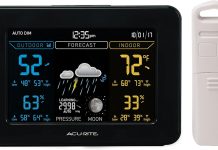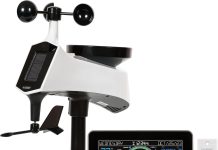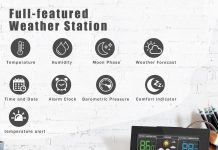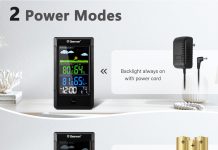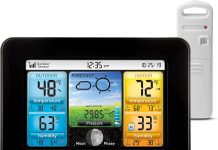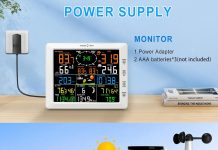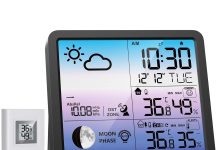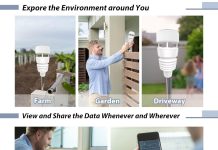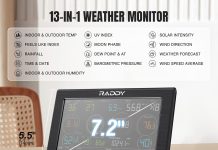Curious about expanding the capabilities of your home weather station? Wondering what additional sensors you can incorporate to measure a wealth of weather data? Look no further! In this article, we will explore the exciting world of enhancing your weather station’s functionality by adding a variety of sensors. From measuring wind speed and direction to monitoring rainfall and UV levels, we’ve got you covered. So, let’s embark on this weather adventure together and discover the endless possibilities of capturing even more accurate and comprehensive weather information.
Temperature Sensors
Outdoor temperature sensor
An outdoor temperature sensor is a valuable addition to any home weather station. It allows us to accurately measure and monitor the temperature outside our homes. This sensor typically consists of a thermometer probe that is placed in the outdoor environment. It provides real-time temperature readings, allowing us to stay informed about the changing weather conditions. Whether we are planning outdoor activities or simply want to know how to dress for the day, an outdoor temperature sensor is an essential tool.
Indoor temperature sensor
In addition to monitoring the weather outside, it is equally important to keep track of the temperature inside our homes. This is where an indoor temperature sensor comes in handy. By placing this sensor in various rooms of our house, we can easily monitor the temperature and ensure optimal comfort. Whether we want to adjust our thermostat or determine if certain areas of our home are experiencing hot or cold spots, an indoor temperature sensor provides vital information to help us create a comfortable living environment.
Humidity Sensors
Outdoor humidity sensor
Humidity plays a significant role in our daily lives, influencing our comfort levels and even the health of our homes. An outdoor humidity sensor allows us to accurately measure the moisture content in the air outside our homes. By monitoring outdoor humidity levels, we can better understand the overall weather patterns and their impact on our surroundings. This information is valuable when planning outdoor activities, as high humidity levels can affect our comfort and well-being.
Indoor humidity sensor
Indoor humidity, just like outdoor humidity, can greatly impact our comfort and health. Excessive humidity can lead to mold growth and damage to our homes, while low humidity can cause dry skin and respiratory issues. An indoor humidity sensor helps us maintain optimal humidity levels inside our homes by providing real-time measurements. With this information, we can make informed decisions about using humidifiers or dehumidifiers, ensuring a healthy and comfortable living environment.
Barometric Pressure Sensors
Barometric pressure sensor
Barometric pressure, also known as atmospheric pressure, is a measure of the force exerted by the atmosphere. Changes in barometric pressure are closely associated with weather patterns and can indicate upcoming weather changes. A barometric pressure sensor allows us to monitor these changes and gain a deeper understanding of the weather conditions in our area. This sensor provides valuable information for weather forecasting and helps us make informed decisions about outdoor activities.
Wind Sensors
Wind speed sensor
Wind speed is a critical factor in understanding weather conditions and assessing their impact on our surroundings. A wind speed sensor measures the rate at which air is moving, providing crucial data for meteorological analysis. By installing a wind speed sensor in our home weather station, we can accurately monitor wind speeds in real-time. This information helps us stay informed about wind conditions and allows us to plan outdoor activities accordingly.
Wind direction sensor
Understanding the direction of the wind is just as important as knowing its speed. A wind direction sensor provides valuable information about the origin and path of the wind. By knowing the wind direction, we can assess the potential impact of weather systems, such as storms or fronts, and plan our activities accordingly. Whether we are interested in outdoor sports, gardening, or simply want to know the prevailing wind patterns in our area, a wind direction sensor is a valuable addition to our home weather station.
Rain Sensors
Rain gauge sensor
Rainfall is a vital component of the Earth’s water cycle and has a significant impact on our lives. A rain gauge sensor allows us to accurately measure the amount of precipitation in a specific area. By monitoring rainfall, we can track weather patterns, water our plants effectively, and assess the impact of storms on our surroundings. A rain gauge sensor is an essential tool for weather enthusiasts and those who want to stay informed about the local weather conditions.
UV Sensors
UV index sensor
Exposure to ultraviolet (UV) radiation from the sun is a concern for both our health and the health of our outdoor activities. A UV index sensor measures the strength of UV radiation and provides important information about potential risks. This information helps us make informed decisions about sun protection, such as applying sunscreen, wearing protective clothing, and avoiding excessive exposure during peak UV hours. By incorporating a UV index sensor into our home weather station, we can prioritize our safety and well-being when spending time outdoors.
Solar Radiation Sensors
Solar radiation sensor
Solar radiation is the energy emitted by the sun that reaches the Earth’s surface. It plays a crucial role in various processes, including climate, agriculture, and solar energy production. A solar radiation sensor measures the amount of solar radiation absorbed by a specific area. By monitoring solar radiation, we can assess the energy available for solar panels, understand the heating potential of our surroundings, and analyze the impact of solar radiation on plant growth. A solar radiation sensor is a valuable tool for those interested in renewable energy and understanding the Earth’s energy balance.
Evapotranspiration Sensors
Evapotranspiration sensor
Evapotranspiration is the combined process of evaporation from the Earth’s surface and transpiration from plants. It is an important component of the water cycle and plays a crucial role in agricultural and environmental studies. An evapotranspiration sensor measures the amount of water vapor released into the atmosphere, helping us understand the water demand and efficiency of plants. By monitoring evapotranspiration, we can make informed decisions about irrigation, water conservation, and agricultural practices, ultimately contributing to sustainable water management.
Soil Moisture Sensors
Soil moisture sensor
The moisture content in the soil has a significant impact on plant growth, agriculture, and water conservation efforts. A soil moisture sensor measures the water content in the soil and provides valuable information about its availability to plants. By monitoring soil moisture levels, we can optimize irrigation practices, prevent over or under-watering, and promote healthier plant growth. Whether we have a home garden or are involved in agricultural activities, a soil moisture sensor is a valuable tool for ensuring optimal plant health and water efficiency.
Lightning Detection Sensors
Lightning detection sensor
Lightning is a powerful natural phenomenon that poses risks to both lives and property. A lightning detection sensor helps monitor and detect lightning strikes in real-time. By incorporating this sensor into our home weather station, we can receive accurate and timely information about lightning activity in our area. This allows us to take appropriate safety measures, such as seeking shelter indoors, when lightning is approaching. A lightning detection sensor is an essential tool for those living in areas prone to thunderstorms and those who want to prioritize their safety during severe weather events.
In conclusion, adding additional sensors to a home weather station can greatly enhance our understanding of weather patterns and their impact on our surroundings. From temperature and humidity sensors to wind and rain sensors, each sensor provides valuable data that allows us to make informed decisions about our daily activities. By investing in these sensors, we can turn our home into a mini-weather station and become better equipped to handle various weather conditions. So, whether we are weather enthusiasts or simply want to stay prepared, adding these sensors to our home weather station is a smart choice.


